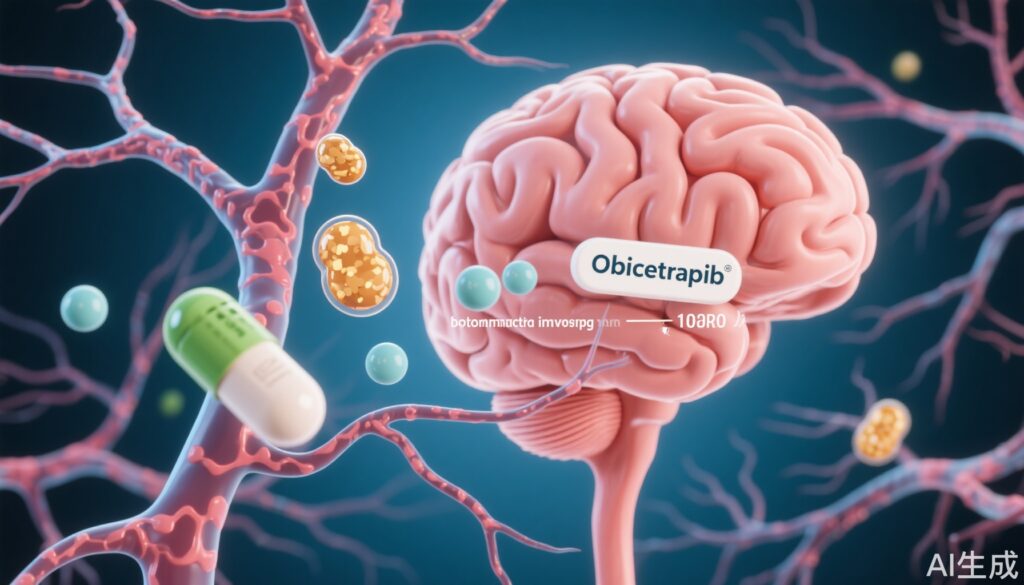Study Background and Disease Burden
Alzheimer’s disease (AD), the most common cause of dementia, represents a critical and growing medical challenge globally due to aging populations. The disease is marked by progressive neurodegeneration, with pathological hallmarks including amyloid-beta plaques and neurofibrillary tangles formed by hyperphosphorylated tau proteins. Recently, disturbed cholesterol metabolism and lipid dysregulation have emerged as pivotal factors in AD biology. The apolipoprotein E (APOE) genotype, particularly the APOE4 allele, strongly influences AD risk by modulating lipid homeostasis and promoting pathology. APOE4 carriers not only have greater AD risk but also increased cardiovascular disease (CVD) risk and susceptibility to side effects from current anti-amyloid therapies, such as amyloid-related imaging abnormalities (ARIA).
Effective therapeutic options that target both cardiovascular health and neurodegeneration remain scarce. Cholesteryl ester transfer protein (CETP) inhibitors have demonstrated efficacy in improving lipid profiles by lowering low-density lipoprotein cholesterol (LDL-C) and increasing high-density lipoprotein cholesterol (HDL-C). Obicetrapib, a novel oral CETP inhibitor, has been approved in cardiovascular disease contexts but its impact on AD pathology had not been clearly defined until recently.
Study Design
The recent analysis stems from the randomized, double-blind BROADWAY trial investigating the lipid-modifying effects of obicetrapib (10 mg orally daily) over 12 months compared to placebo, in patients aged 66-70 years with atherosclerotic cardiovascular disease (ASCVD) or heterozygous familial hypercholesterolemia (HeFH) who were on maximally tolerated lipid therapies including statins. Since baseline statin therapy did not adequately reduce cholesterol levels, obicetrapib was used as an adjunct.
The trial enrolled 1515 participants, 32.9% female, predominantly White (84.6%), and 21.3% APOE4 carriers. Cardiovascular risk factors were prevalent, including diabetes (37.8%) and hypertension (84.7%).
Alzheimer’s biomarkers — phosphorylated tau 217 (p-tau217), p-tau181, amyloid-beta (A) 42/40 ratio, glial fibrillary acidic protein (GFAP), and neurofilament light chain (NFL) — were measured at baseline and at 12 months to assess neurodegenerative pathology progression. The primary endpoint was change in p-tau217, an early and sensitive indicator of AD pathology.
Key Findings
Obicetrapib demonstrated a significant effect in slowing AD biomarker progression over 12 months. The mean percentage increase in p-tau217 was significantly lower in the treatment group (1.99%) versus placebo (4.98%, P = .0188), indicating reduced progression of tau pathology. Moreover, the p-tau217/A42/40 ratio also improved significantly (2.51% vs 6.55%, P = .0042).
Other biomarkers such as GFAP and NFL showed trends favoring obicetrapib but did not reach statistical significance, likely due to the relatively short study duration and sample size.
In the APOE4 homozygotes (E4/E4, n=29), a subgroup analysis revealed a striking 20.48% between-group difference in p-tau217 change (-7.81% decrease with obicetrapib versus +12.67% increase with placebo, P = .010), suggesting greater therapeutic responsiveness in this high-risk genotype group. E4 carriers also showed greater improvements in NFL and GFAP.
Lipid effects were consistent with prior reports: obicetrapib reduced LDL cholesterol by 33% relative to placebo (P < .0001) and increased HDL cholesterol significantly by day 84.
The safety profile of obicetrapib was favorable, with adverse event frequency and severity comparable to placebo (59.7% vs 60.8%), supporting tolerability in this population.
Expert Commentary
Philip Scheltens, MD, PhD, the study investigator and neurologist at Amsterdam UMC, highlighted the dual significance of the findings: “AD and cardiovascular disease are interlinked, especially through the APOE4 allele. This study provides compelling evidence that managing cholesterol with obicetrapib can beneficially influence AD pathology as assessed by highly sensitive biomarkers.”
He emphasized that the findings represent a novel pharmacological breakthrough, noting that prior lipid-lowering therapies, including statins, have failed to demonstrate effects on AD progression.
The biological plausibility arises from the close relationship between cholesterol metabolism, APOE genotype, and amyloid-tau pathophysiology. Elevation of LDL cholesterol and reduction of protective HDL cholesterol contribute to AD risk and progression, linking vascular and neurodegenerative processes.
Limitations include the early stage of biomarker research, the predominantly White study population, and the need for cognitive and functional outcome data. Larger studies with longer follow-up and diverse cohorts are essential.
Conclusion
This pioneering study suggests that obicetrapib, a CETP inhibitor with proven cardiovascular benefits, may also slow biochemical markers of Alzheimer’s disease progression, especially in APOE4 carriers. The dual targeting of lipid metabolism and AD pathology could pave the way for integrated treatment strategies addressing shared pathogenic mechanisms.
Future research should focus on replication in patients with mild cognitive impairment due to AD, inclusion of cognitive assessments, and exploration of mechanistic pathways. If confirmed, obicetrapib may represent a significant advancement in bridging cardiovascular and neurodegenerative disease management, transforming the approach to preventing and treating AD in high-risk populations.
References
1. Scheltens P, et al. Obicetrapib reduces progression of Alzheimer’s disease biomarkers: results from the BROADWAY trial. Presented at Alzheimer’s Association International Conference (AAIC) 2025; July 30, 2025.
2. The Lancet Commission on Dementia Prevention, Intervention, and Care. Lancet. 2020;396(10248):413–446.
3. Corder EH, et al. Gene dose of apolipoprotein E type 4 allele and the risk of Alzheimer’s disease in late onset families. Science. 1993;261(5123):921-923.
4. Barter PJ, et al. Cholesteryl ester transfer protein: a novel target for raising HDL and inhibiting atherosclerosis. Curr Opin Lipidol. 2002;13(4):377-384.
5. Salloway S, et al. Amyloid-related Imaging Abnormalities in studies of anti-amyloid antibodies: incidence and management. Neurology. 2020;95(9):e1346-e1357.


